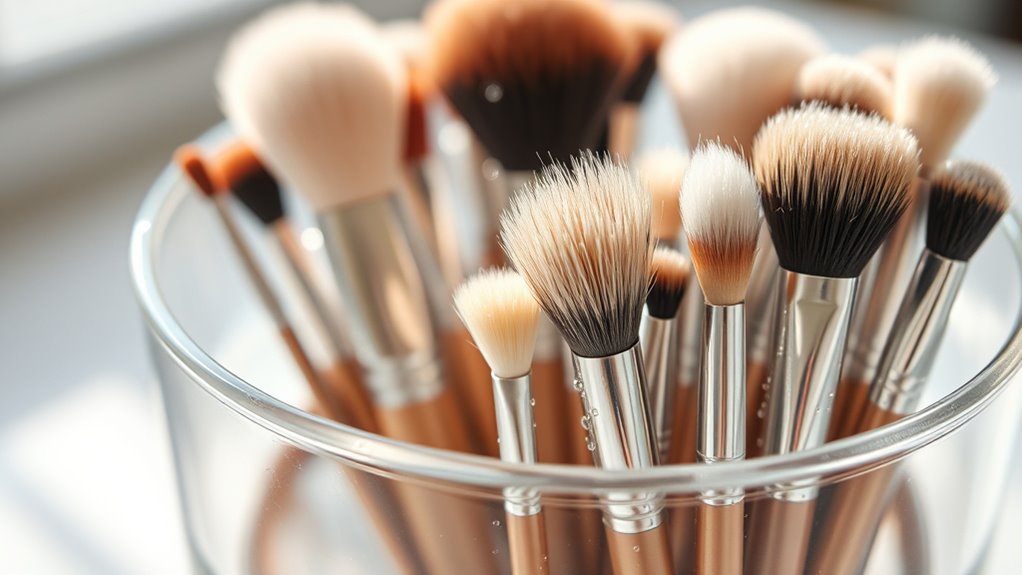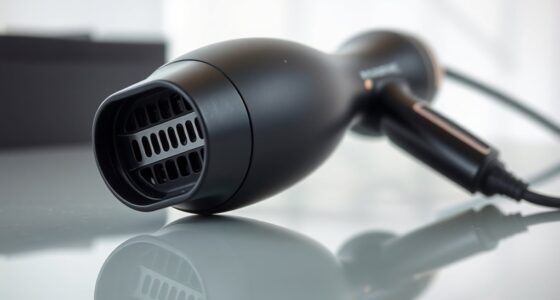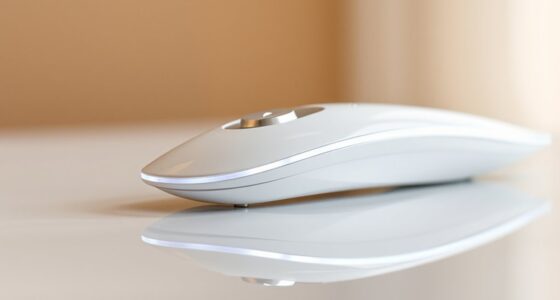To keep your makeup brushes spotless and your skin healthy, follow the pros’ sanitizing routine. After each use, wipe off excess product with a tissue. Weekly, wash your brushes using warm water, gentle cleaner, and a calming swirl to remove buildup. Rinse until clear, then reshape and air dry flat to prevent damage. Regular sanitizing keeps your brushes hygienic and your makeup flawless—discover more tips for perfect results as you continue on.
Key Takeaways
- Regularly sanitize brushes to eliminate bacteria, oil, and leftover product, ensuring hygienic makeup application.
- Use gentle cleansers and proper rinsing techniques to thoroughly remove buildup without damaging bristles.
- Allow brushes to air dry completely on a flat surface to preserve brush shape and longevity.
- Incorporate weekly deep cleaning and sanitizing into your routine for optimal skin health.
- Proper cleaning extends the lifespan of brushes, maintaining makeup quality and preventing skin issues.

Keeping your makeup brushes clean is essential for healthy skin and flawless application. Dirty brushes can harbor bacteria, oil, and leftover product, which may lead to breakouts, skin irritation, or infections. Regularly sanitizing your brushes not only keeps your skin safer but also ensures your makeup looks its best every time you apply it. When you follow a consistent sanitizing routine, you prevent product buildup and extend the lifespan of your brushes, saving you money in the long run.
Keeping your brushes clean promotes healthier skin and flawless makeup application.
Start by removing any excess makeup from your brushes after each use. Gently wipe the bristles with a clean tissue or brush wipe to eliminate surface residue. This quick step reduces the amount of buildup that can lead to bacteria growth. Once a week, dedicate time to a thorough cleaning. Use a gentle brush cleaner or a mild shampoo mixed with water. Avoid harsh chemicals that can damage the bristles or cause them to fall out. Submerge only the brush head, keeping the handle dry to prevent loosening the glue or damaging the brush.
To sanitize your brushes effectively, rinse the bristles thoroughly under lukewarm water, pointing the brush downward to prevent water from seeping into the handle. Apply the cleaner to the bristles and work up a lather by gentle swirling. Pay attention to the base of the bristles, where product tends to accumulate. Rinse again until the water runs clear, indicating all makeup and dirt have been removed. After washing, gently squeeze out excess water with a clean towel or cloth. Reshape the bristles to maintain their original form, then lay the brushes flat on a clean towel to air dry. Proper drying prevents water damage and helps maintain brush integrity.
Avoid drying brushes upright with the bristles pointing upward, as water can seep into the handle and weaken the glue. Instead, lay them flat to prevent water from collecting at the base. Once dry, your brushes will be clean, sanitized, and ready for their next use. Keep in mind that regularly sanitizing your brushes not only makes your makeup application more hygienic but also helps prevent potential skin issues. Incorporating this routine into your beauty habits, and choosing high-quality filtration methods, will ensure your brushes stay clean and your skin stays healthy. You’ll notice a difference in your skin’s health and the overall look of your makeup. Properly cleaned brushes are an investment in both your skincare and your makeup results.
Frequently Asked Questions
How Often Should I Replace My Makeup Brushes?
You should replace your makeup brushes every 6 to 12 months, depending on usage and brush quality. Regularly cleaning them extends their life, but over time, brushes can harbor bacteria and lose their shape, which affects application. If you notice frayed bristles, persistent stains, or if they smell bad even after cleaning, it’s time to get new ones. Proper care and timely replacement keep your skin healthy and makeup flawless.
Can I Sanitize Brushes With Alcohol Regularly?
Yes, you can sanitize your brushes with alcohol regularly, much like a knight invigorating their armor. Douse a clean cloth or spray alcohol onto your brushes after each use, letting them air dry. This quick ritual helps eliminate bacteria and keeps your tools safe. Just remember, alcohol can dry out bristles over time, so don’t overdo it—think of it as a gentle shield, not a harsh attack.
Are There Eco-Friendly Brush Sanitizing Options?
Yes, there are eco-friendly brush sanitizing options you can try. Look for natural disinfectants like witch hazel, tea tree oil, or vinegar, which effectively sanitize without harsh chemicals. You can also use reusable, biodegradable brush wipes or sprays formulated with plant-based ingredients. These alternatives are gentle on the environment while keeping your brushes clean and safe. Always guarantee proper drying to prevent bacteria buildup.
What’s the Best Way to Dry Brushes After Cleaning?
After cleaning your brushes, the best way to dry them is to lay them flat on a clean towel, with bristles hanging slightly off the edge to prevent water from seeping into the handle. You can also stand them upright in a cup, bristles up, to promote air circulation. Avoid drying with heat or using a hairdryer, as these can damage the brushes and diminish their lifespan.
Do Professional Makeup Artists Have Different Sanitizing Routines?
Yes, professional makeup artists often have different sanitizing routines. They typically disinfect more frequently, using specialized solutions or UV sterilizers to guarantee their brushes are hygienic for each client. They also have systematic cleaning schedules, often cleaning brushes after every use, and store them properly to prevent contamination. This meticulous approach helps maintain high hygiene standards, ensuring their clients’ safety and the quality of their work.
Conclusion
Incorporating a regular sanitizing routine for your makeup brushes isn’t just about cleanliness—it’s about protecting your skin and overall health. Did you know that makeup brushes can harbor up to 100,000 bacteria if not cleaned properly? That’s a staggering number that highlights the importance of consistent sanitizing. By making this a habit, you reduce your risk of breakouts and infections, ensuring your beauty routine stays safe and effective. Your skin will thank you for it!









